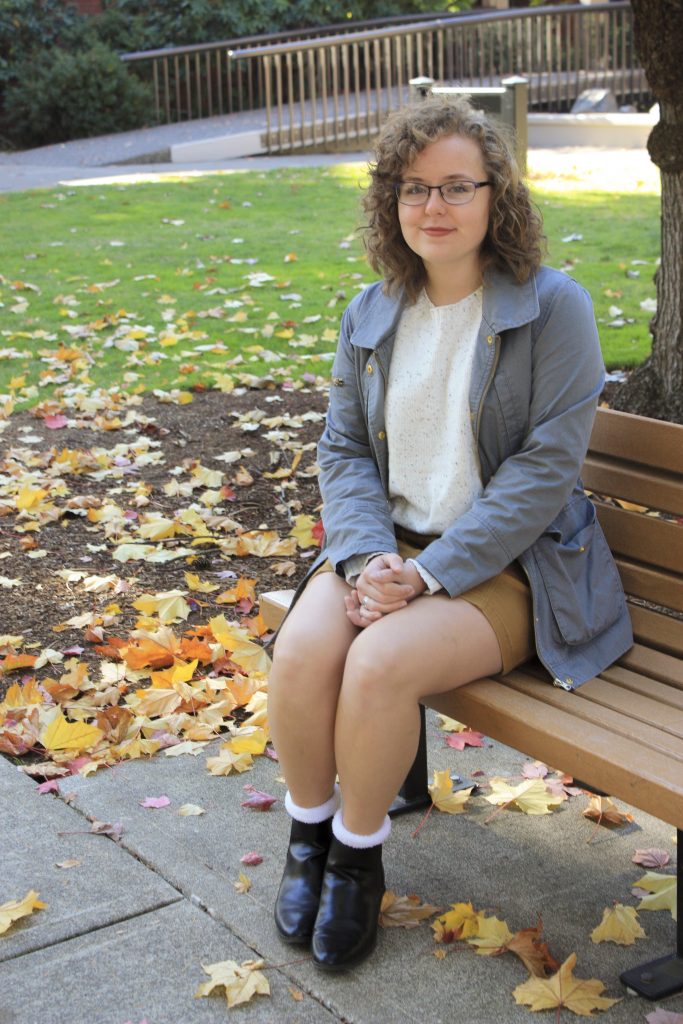Ashlynn Norton | Digital Media Manager Alyssa Martin | Freelancer Cora McClain | Editor in Chief
Ashlynn:
Look #1 – The every day/night look to fall for
This is one of my go-to looks for fall. For me, it’s really fast and easy. I find that as a person with glasses, my makeup can get hidden by the shadows of my glasses, so going a little darker keeps my makeup from disappearing.

Products:
MaryKay Eyeshadow: Auburn
Mary Kay Eyeshadow: Coal
Milk Kush Mascara
Step 1: Take any copper color (I used Mary Kay’s “Auburn”). Put the color on your eyelid and take it a little above the lid.
Step 2: With black eyeshadow (I used Mary Kay’s “Coal”), take your finger and swipe the color onto your eyelid. I find that when applying a single color to your eyelid, using your finger really helps pack the color on, in comparison to using a brush. Alternatively, if you don’t want to use black, a dark brown would work just as good.
Step 3: I like to finish this off with winged eyeliner and my favorite mascara by Milk.
Optional: I think this look pairs well with a nude brown lipstick, but would also go well with a dark brown or red.
Look #2 – The punk/more colorful autumn
I love super colorful makeup. I was inspired by the amazing fall sunsets to create a look that is a little more on the colorful side but is also still pretty simple. This look is great for pretty much everyone.

Products:
BH Take Me Back to Brazil Eyeshadow Palette
Milk Kush Mascara
Step 1: For this look, you will want to use a lighter copper color and put that on your eyelid and a little above that. (Unfortunately, the palette I used doesn’t have names for the shades so I can’t tell you exactly what colors I used.)
Step 2: Using your finger, take a dark purple and apply that on your eyelid.
Step 3: Take a dark brown shade and put that in your crease to add dimension.
Step 4: Again, I finish this look off with winged eyeliner and my Milk Kush mascara.
Optional: I really like to finish this off with a bright red lipstick, but this would also look good with a dark brown.
Cora:
Look: The just-out-of-the-oven-pumpkin
This is my first experimentation with warm-toned eyeshadow. What started as a fun, bright orange soon turned smokey with a touch of dark brown. Using a bold lip can help balance out the darkness of this look.

Products:
Elf Rose Gold – Sunset Eyeshadow : Auburn
Elf Rose Gold – Sunset Eyeshadow : Brown
Elf Rose Gold – Sunset Eyeshadow : Gold
Wet n Wild Matte Lip : A362
Loreal Paris mascara : Voluminous Original
Step 1: Use a light matte auburn color as the base of this look. Cover your lid completely.
Step 2: To add some depth, take a matte dark brown and lightly add the color to the outer edge of your lid and along your crease. If it ends up outside of your eyelid, you can use concealer or foundation to clean up any mistakes once you’re done.
Step 3: Blend the two colors together; this should soften the harsh lines between the brown and auburn and soften the boldness of the brown. Usually this is best done with a soft brush with longer bristles, so I recommend using a blending brush.
Step 4: I like to highlight the middle of my lid in most of my looks, so I use a glittery dark gold to make my smokey eye pop. Highlighting the inner eye with this color can also make your look pop.
Step 5: Finish your eyes off with whatever mascara you like, either a black or brown color can work with this look. I generally like doing this instead of curling my eyelashes since it puts less stress on them.
Step 6 : Use a bold lip to balance out the bold eye, I used the “looking for truffle” color of Wet n Wild.
Alyssa:
Look: The ‘Carmel Apple’ look is perfectly scrumptious to wear day or night……..
I am far from a makeup guru so this look is easy and quick. I like adding a more shimmering color as an accent but you can definitely do this look with a matte finish.

Products:
Lashes – Lash Sensational by Maybelline New York
Lips – 120 Go Wild by Almay
Eyes – Base: BB Cream-Nude by NYX
Eyeshadow: A362 Looking For Truffle Velvet Matte Lip Color by Wet n Wild
Accent Eyeshadow: Color Wonderland Palette (on the ‘Neutrals’ side) by Sephora
Step 1: I use a small soft paintbrush to apply BB cream onto my eyelids but you can use your finger or whatever else works for you. Apply a thin layer of BB cream onto the desired area of the lid just enough to coat the entire area you want. This will help the color stay on the lid.
Step 2: Dab the eyeshadow onto the base, evenly applying the color onto the lid. I am using a matte lipstick as the eyeshadow, but hey, when it works, it works. Continue applying the color onto the lid until you get the desired brightness.
Step 3: Apply a small amount of BB cream at the inner corners of the lid and going until a little less than halfway across the lid. This will help the accent color pop out more.
Step 4: Dab the accent eyeshadow directly onto the new BB cream and blend where the two eyeshadows meet.
Step 5: Apply mascara onto both the top and bottom lashes.
Step 6: To finish the look, apply lipstick and you are done! Now you’ve got a look that can be both festive and cute.
Contact the authors at amartin17@wou.edu & anorton17@wou.edu
Photos by Ashlynn Norton, Alyssa Martin, and Cora McClain






















